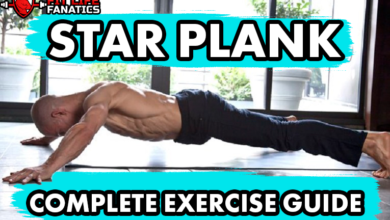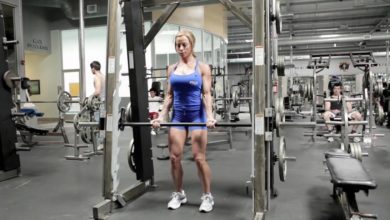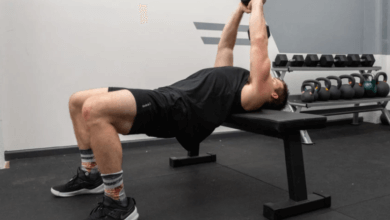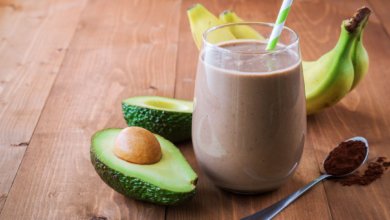Setting Up A Basement Gym Low Ceiling
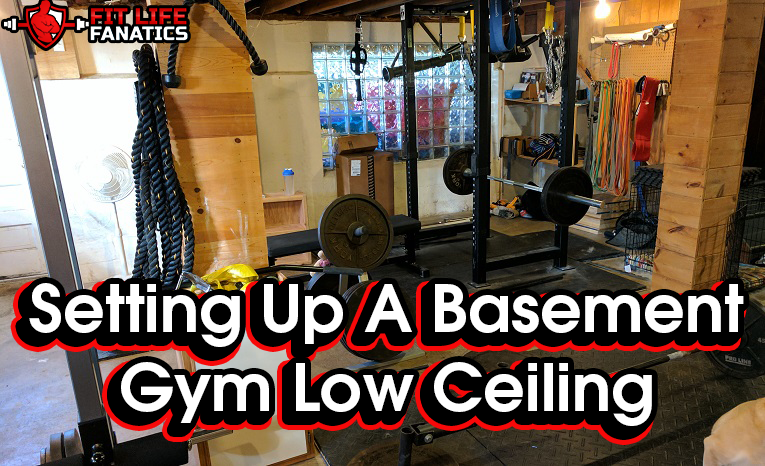
Having a gym, right at home is always advantageous. You can lift at your convenience, avoid the bottleneck traffic, and in current circumstances, stay at an arm’s length from potentially contaminated surfaces.
That said, not all homes are capacious enough to house fully-loaded gyms. That’s why god made basements.
Basements are nearly perfect for setting up gyms, with a few caveats of course. More often than not, it’s the caveats that limit people from leveraging this viable option.
That’s what we are going to decode today.
Having worked on three DIY basement gym projects after the pandemic, we have a fair bit of perspective on what works and what does not. We have it all listed for you in bite-sized chunks.
So, strap in.
Is Converting a Basement to A Low Ceiling Gym Worth It? – Let’s Find Out

First things first, is it even worth it?
Absolutely!
Numerous doubts can creep up in your mind when you decide to set up a basement gym. But the ‘worthiness’ or the lack of it, should not be one of those.
It’s a no-brainer. A basement gym is a permanent addition to your home. One that will bring many perks to the table.
Like these
Convenience
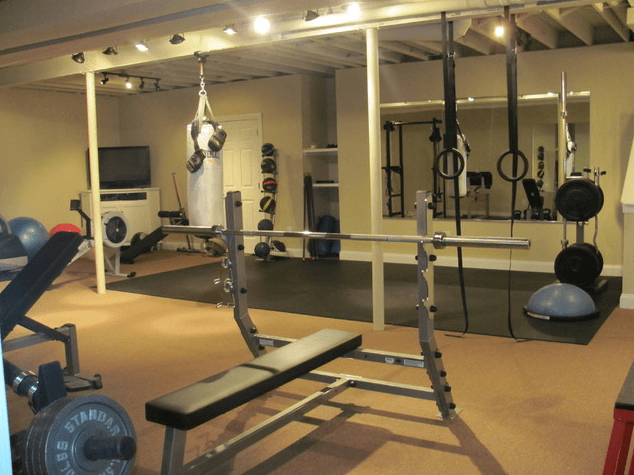
You are no longer limited by time constraints, or work schedules. Finished work in the middle of the night and raring to lift some iron? Head to the basement. It’s minus five outside? Head to the basement.
Health

The average American’s fitness has never been worth boasting about. But the Covid-19 pandemic has worsened it. With a gym at home, regardless of the equipment, you have one less reason to skip workout.
Perceived Value

A gym is pretty much like a pool. It can increase the perceived value of your home for certain categories of buyers. Even if you have no plans to sell your home in the near future, think of it like an investment towards your health.
The second biggest hurdle that people face while setting up a basement gym is the basement height.
Do Most Basement Gyms Have a Low Ceiling?
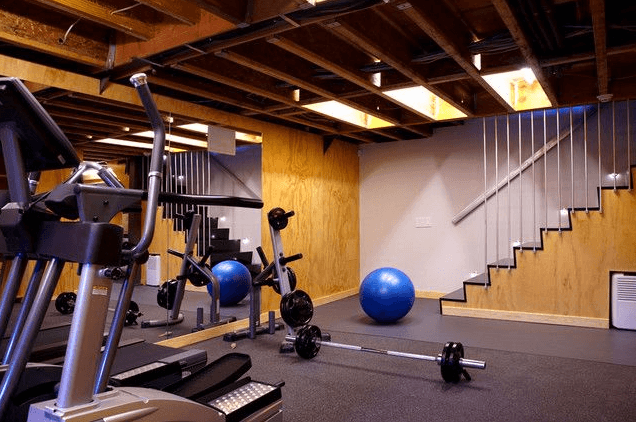
If your house was built to International Residential Code (IRC), then chances are that you have an 84” ceiling. Canadian homes have 96” basements.
The size (width) of the basement can vary depending on how big the house is. There are basements that are as small as 650 sq. feet and as large as 5000 sq feet.
The challenge though lies in the vertical space, or the lack of it.
Some homes may have even lower basement ceilings, especially if there are exposed beams or girders. But the chances of the basement height being more than 7-feet are slim.
What you need to ask yourself is, whether 7-feet of vertical space is enough to exercise with a full range of motion in your overhead exercises.
That depends. For now, let’s take a look at some of the pros and cons of a basement gym with a low ceiling.
Pros
here are the pros you get when have a basement gym with low ceiling
Great use of space

In most homes, the basement is a dark & dingy space for all things unnecessary. In other words, a glorified store room. Turning it into a gym is much better utilization of the available space.
Comfortable Temperatures
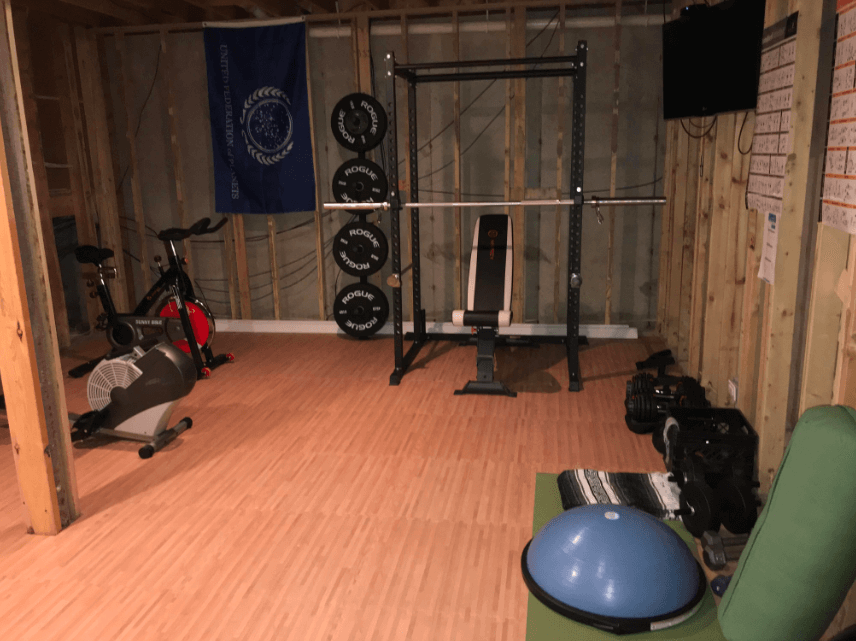
Regardless of whether its summer or winter, basement temperatures will generally be better than outside. In summer, unfinished basements are cooler, whereas they are a little warmer in winter. If you have a finished basement, the temperature will be stable year round.
That Concrete Floor

When you fail mid rep and drop that fully loaded barbell on your precious Maple wood floor, it will break your heart before the floor cracks. Basements come with concrete slabs for flooring. Even if you don’t want to spend on gym flooring, be rest assured that you are not going to do much damage by dropping weights.
Sound Proof (Almost)
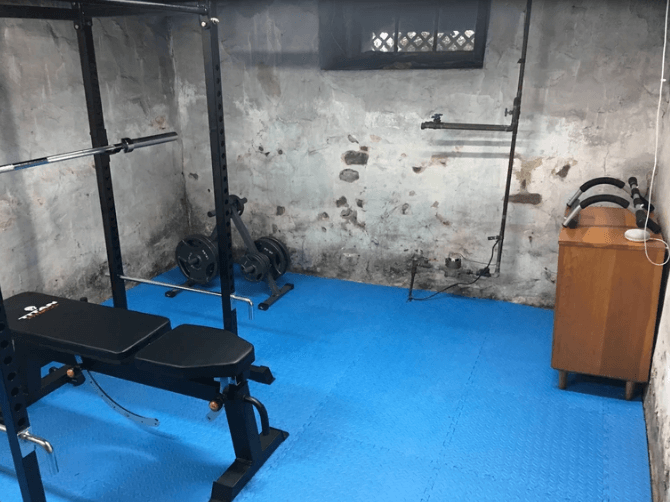
Basements are almost naturally sound proof because of the thick concrete outer walls and the surrounding ground. While not 100% sound proof, it’s pretty unlikely that you will wake your pesky neighbor in the middle of the night while you test the limits of your new audio system.
Cons
here are a few downsides of having a low ceiling basement gym.
Low Ceilings

While low ceilings do not limit the functionality of your basement anymore (courtesy specialized basement gym equipment), it’s impossible to perform certain exercises in case you are 6-feet or taller. That’s even with specialized equipment, mind you.
Moisture
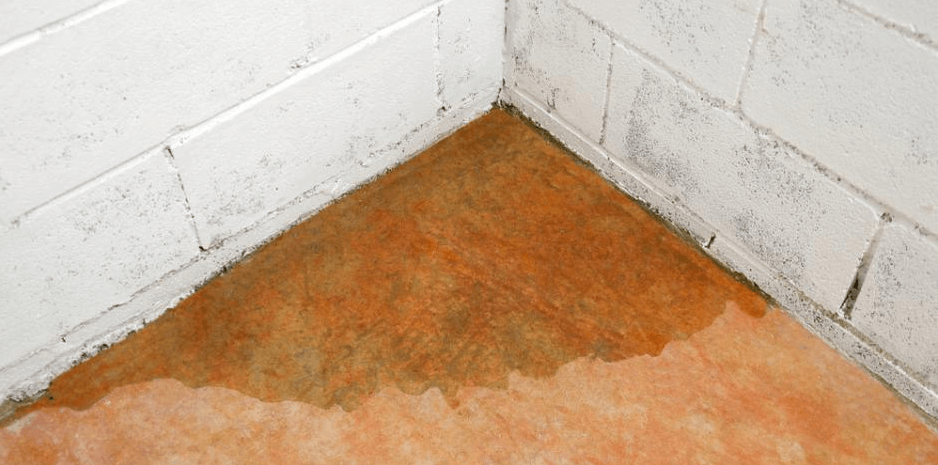
Moisture and iron = rust. If you still haven’t, you will have to fix the ventilation before you set up the gym.
Setting it up
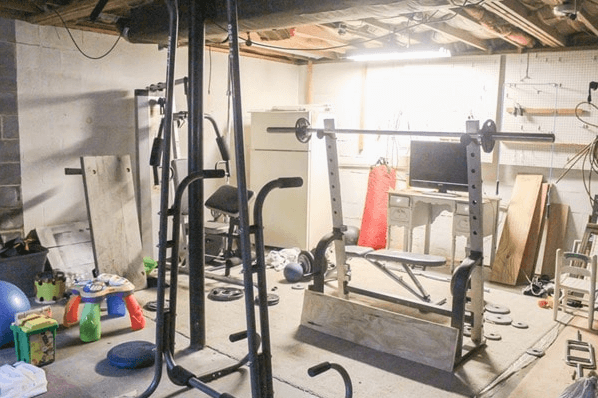
Unless your basement has separate access from the side, it may be a little difficult to carry your equipment down a narrow stairway. Having said that, most gym equipment these days come disassembled in separate boxes.
How Expensive Is It to Convert a Basement to A Low Ceiling Gym?

The average cost of a basement remodel is $50,000.
Before you faint and are wheeled into an ER, that’s just a ballpark number for a complete overhaul including stairs, waterproofing, vacuum, soundproofing and the gym.
The average cost for setting up a gym in a fully finished, or unfinished basement is around $4000. Whew!
The amount of money it will cost you will depend on the current condition of your basement. Btw, you can have a barebones gym too. There are no rules to follow.
As long as it’s ventilated, bright and offers enough clearance for your workouts, you are good to go with whatever suits your budget.
What to Keep in Mind While Converting a Basement to A Low Ceiling Gym?

Okay, so you have made up your mind to convert your dingy basement into a swanky gym, or a rustic one. Great decision. You’ll thank yourself every time you don’t have to haul your ass to a freezing garage.
But, how do you even get started with the makeover? Here’s a brief guide.
Map Everything Out
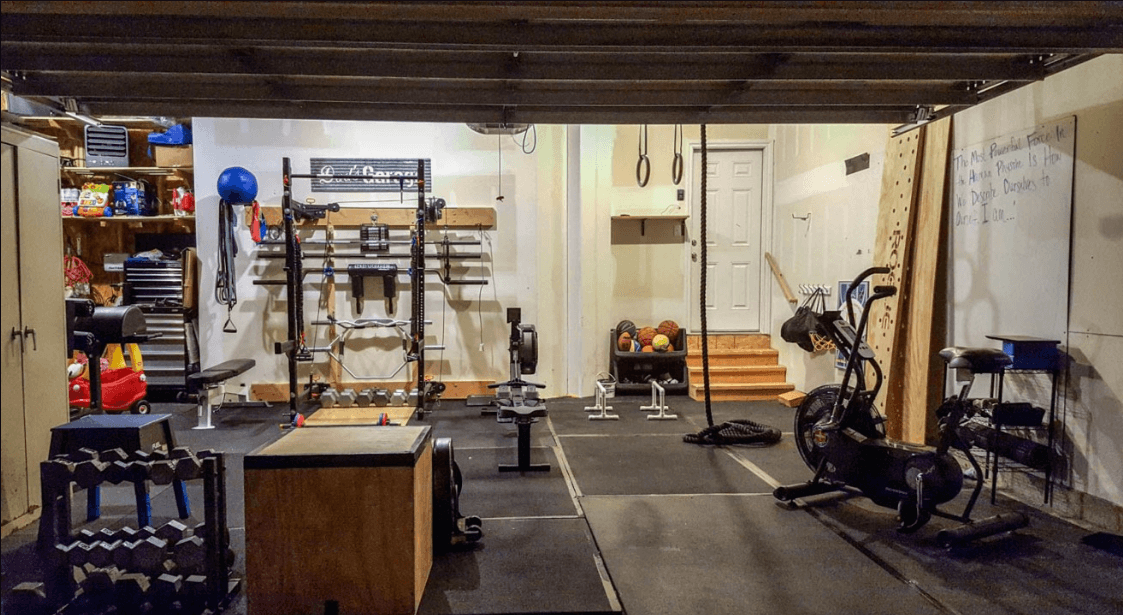
Grab a paper and a pen and jot everything down. What is the current condition of your basement (starting point)? How do you envision it when everything’s completed (End point)? This very basic step should give you an estimate of the expenses involved in the remodel. For instance, if you skip flooring, walls, ventilation and temperature control, the rest is pretty economical. But if you add these, the cost can escalate fast along with the TAT.
Measure everything
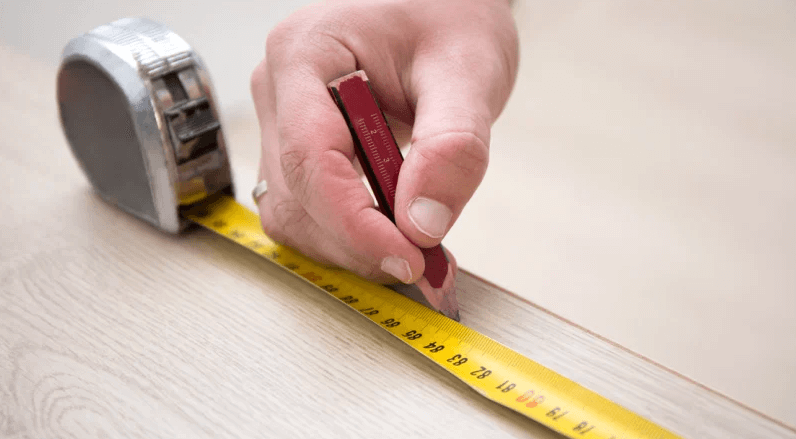
Grab a measure tape and measure the height, width and depth of the basement accurately. The distance from floor to ceiling, wall to wall, floor to joists, exposed girders and anything else that you feel is necessary.
Intended Use/Fitness Goals

What best defines your fitness goal? Are you a powerlifter? Are you looking to lift heavy weights? Are you a fitness buff who follows a PPL plan? Maybe you are looking to train for Olympic lifts. Your choice of equipment will vary depending on your answer to this.
Equipment
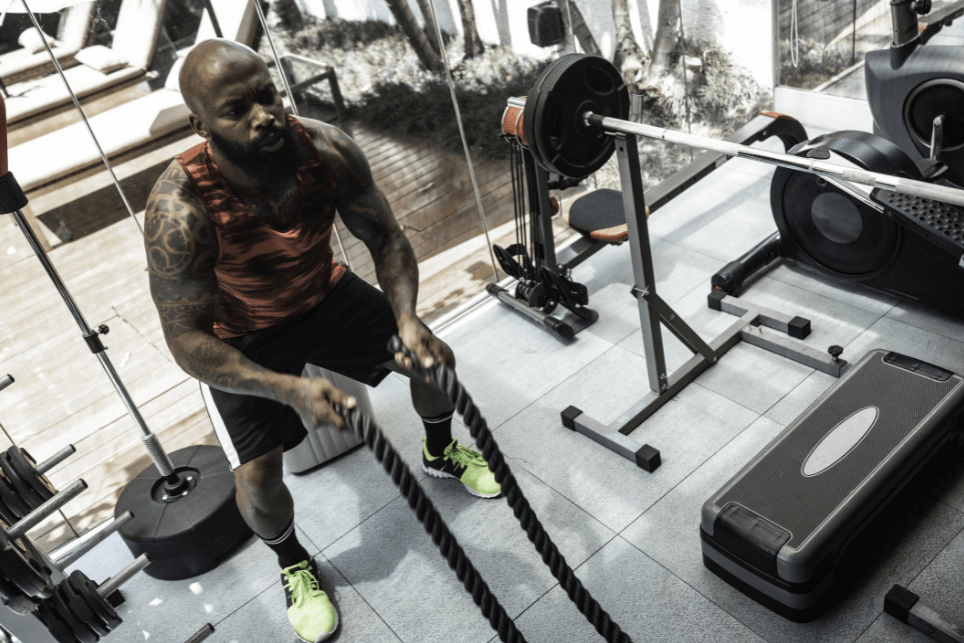
Do you have a list of equipment sorted by priority? There’s equipment that you absolutely cannot do without, and there are some vanity additions too. Yeah, we all secretly yearn for that fancy ‘As seen on TV’ bar. Now depending on the available room and your budget, start to trim down the list. Stick to the essentials only.
Lookup for plans
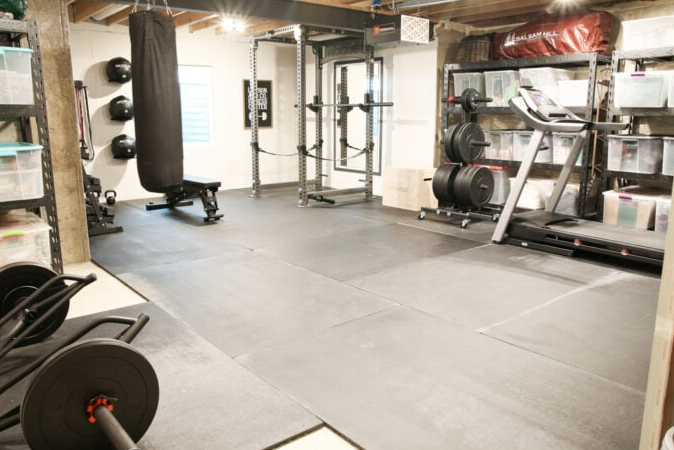
There are many websites and forums that list plans for DIY gym makeovers. Look up a get some inspiration with design. Reddit is a treasure-trove of information for DIYers.
How to Prepare the Basement for A Low Ceiling Gym
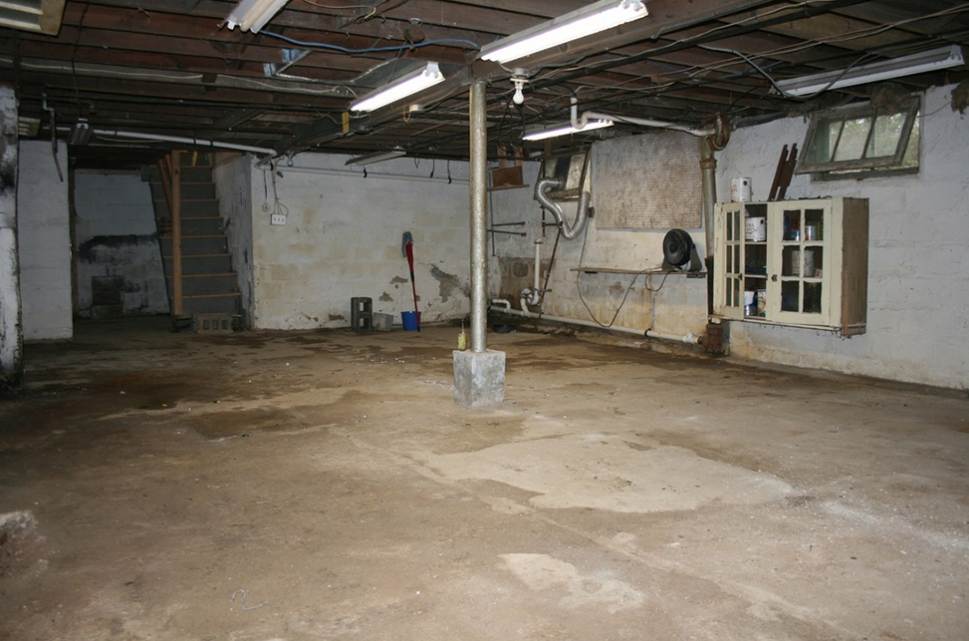
It’s time to put the plan into action. Start out by getting all the equipment you need to prep the basement. The painting clothes, safety goggles, gloves and a gas mask if you foresee running into mildew and/or noxious fumes (drylok).
Clear everything that’s in the basement. Do the walls demand a fresh coat of paint? Maybe the flooring can be overhauled too. Fix the moisture problems and ensure that there’s ample ventilation. We will touch on the technical bits in a bit.
What Types of Flooring Can Be Used?
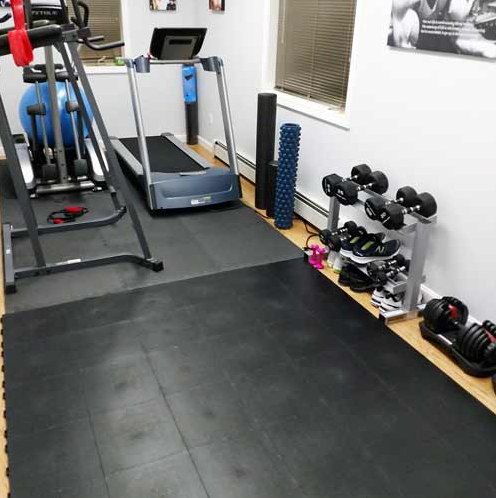
Right from the unsung carpet to the luxury vinyl flooring, your options are extensive. It all boils down to the Benjamin you are willing to spend on it.
The way we look at it, any type of flooring that ticks these three boxes work fine in a home gym.
- Durable – Should be able to withstand the wear and tear that comes with sweat, grime and earth-shattering weights being dropped on it
- Traction – Should provide you and the equipment with enough traction. You don’t want to slip on a concrete floor, especially when you are hauling a 100 lb. barbell over your head.
- Shock absorption – In case you do slip, this will have you covered. When you are as steady as a pole, it will ensure that you don’t end up with joint aches.
That said, here are some of the popular options.
Can Rubber Flooring be used for a low ceiling gym?
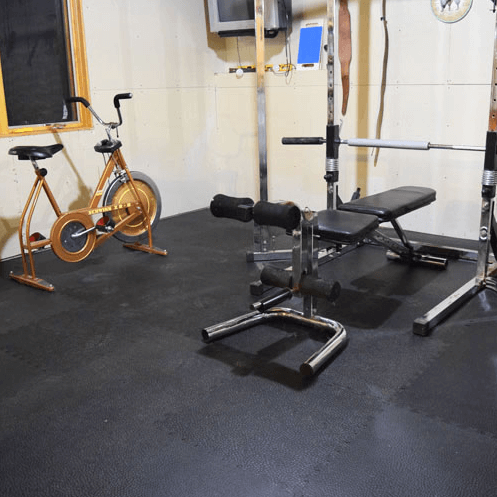
Rubber flooring is probably your best bet. It can be installed on any type of flooring, provides great traction, shock absorption and can probably withstand everything that you throw at it.Bonus points for being cheaper than anything else.
These are also available in varying thickness. So, you don’t have to buy an inch-thick flooring if you feel that it takes away a precious inch from the overhead height. ½” thick flooring works equally well, especially with a concrete floor under it.
You can find some excellent options that will cover a reasonable-sized basement for less than $300.
Can Plywood Flooring be used for a low ceiling gym?
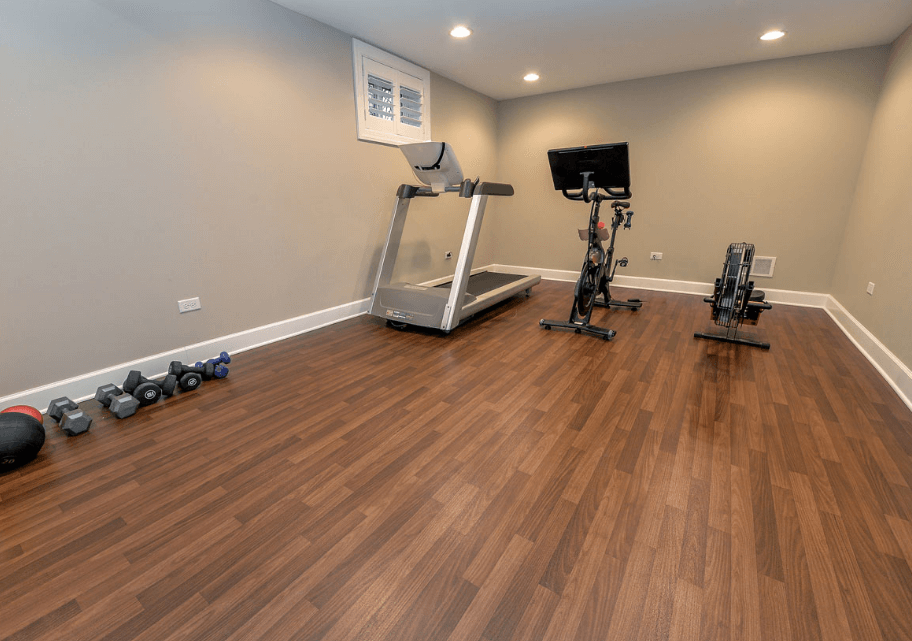
Yes, it can. Plywood flooring is generally installed between the concrete floor and the upper layer (rubber mat). This is typically done to protect the hard concrete floor from cracking and/or dings, that are inevitable if you drop weights on them.
The other use is when the floor isn’t level and you want to level it out.
Do they work? Sure, they do. But are they necessary? Not imho.
Some people add plywood floor under the squat rack/cage only. That might be a good option if you do deadlifts and any weight dropping generally occurs in that part of the gym.
Can Hardwood or Laminate Flooring be used for a low ceiling gym?
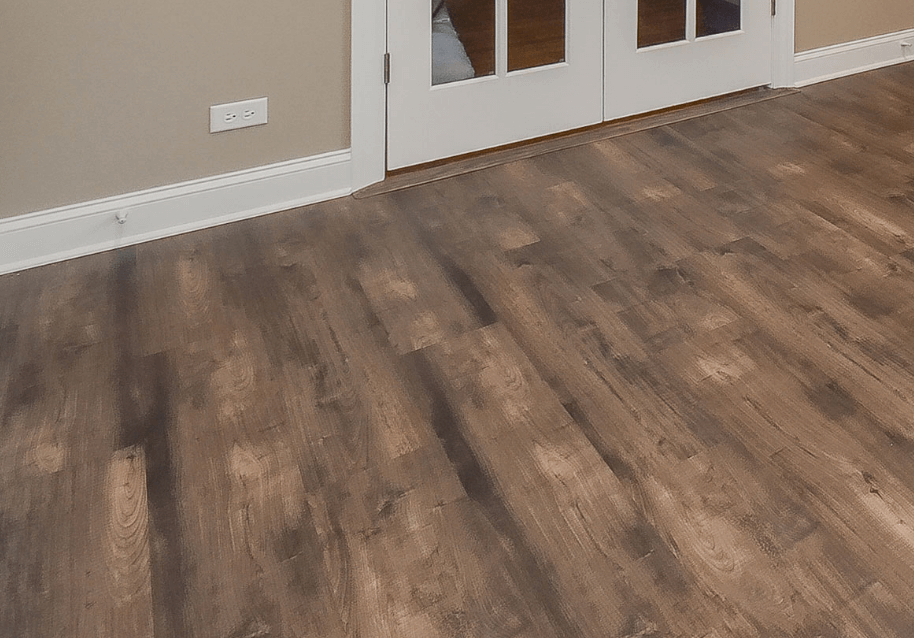
Hardwood or Laminate flooring is generally not the first choice of flooring material for a home gym. That said, there’s no reason why it cannot be used. Hardwood offers great aesthetics and durability.
There are however, some factors to consider. For instance, you’d want to pick a hardwood that rates high on the Janka scale. The Janka rating determines the pressure it takes to create an indentation on a hardwood plank using a steel ball. Maple wood has a Janka rating of 1650, which is terrific for home use. But Meh for a gym floor.
Some engineered wood are rated as high as 3000. But higher the rating, steeper the price.
Laminate might be a great option as long as you are not using heavy weights. Yoga, Calisthenics and Spinning studios are probably the best settings for Laminate.
What Types of Lighting Can Be Used in A Home Gym?
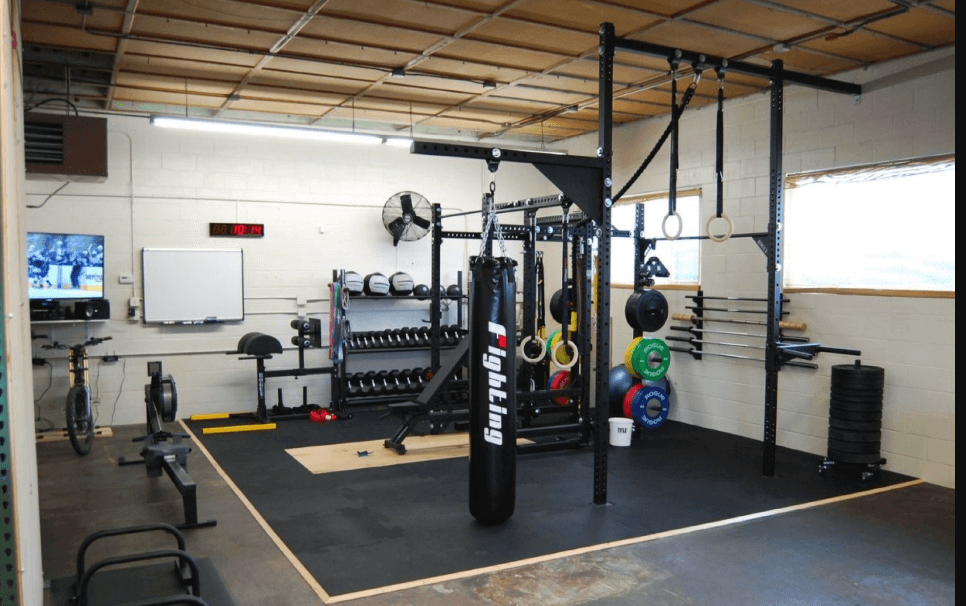
Assuming that your basement has very little, or no natural light, you’d ideally want to light up your gym to mimic the natural light of the sun. This goes beyond the aesthetics, mind you. Science says that brighter lights can make you more alert and energetic, which can influence your performance in the gym.
Some people take a cue from Fitness clubs and prefer mood lighting, which is beyond the scope of this article, because the sky’s the limit really.
Instead, we are going to focus on the different types of lights and their pros and cons.
Before you begin, ensure that you have measured the space and created a plan for installing the light fixtures. Look up for any existing fixtures or sockets that can be used.
How Much Lighting Do You Need?
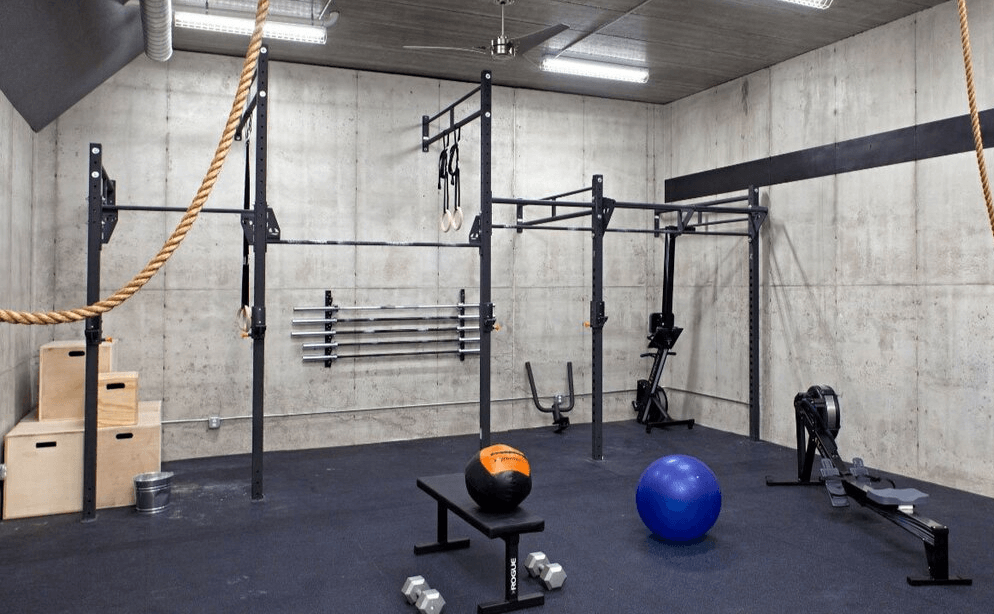
There are tons of permutations and combinations that go into determining the exact amount of light that you need in a gym. Even if you were to run all of them, it could still end up being imperfect.
Rather than being hung up over technical gobbledygook like lumens and foot candles, buy a few extra light fixtures. Install them and return the ones you don’t need. That way, you can try them out and get a fair idea of how the gym looks.
In case you are still curious, here’s a great resource to help you understand some ballpark calculations for the amount of light that’s considered ideal for different residential settings.
Even Lighting

The first and most basic way to light up your low ceiling basement gym is to spread out the light fixtures evenly. This way, moving the equipment doesn’t affect the available light.
Spot lighting

The other way is to install the lights around the equipment. This works great too. But what if you decide to move a large equipment to the other corner? You’d have to ensure that you move the light fixture too.
That said, with some planning, you can get the best of both worlds.
Here’s some of the common types of lights used in basement gyms.
Overhead Lights
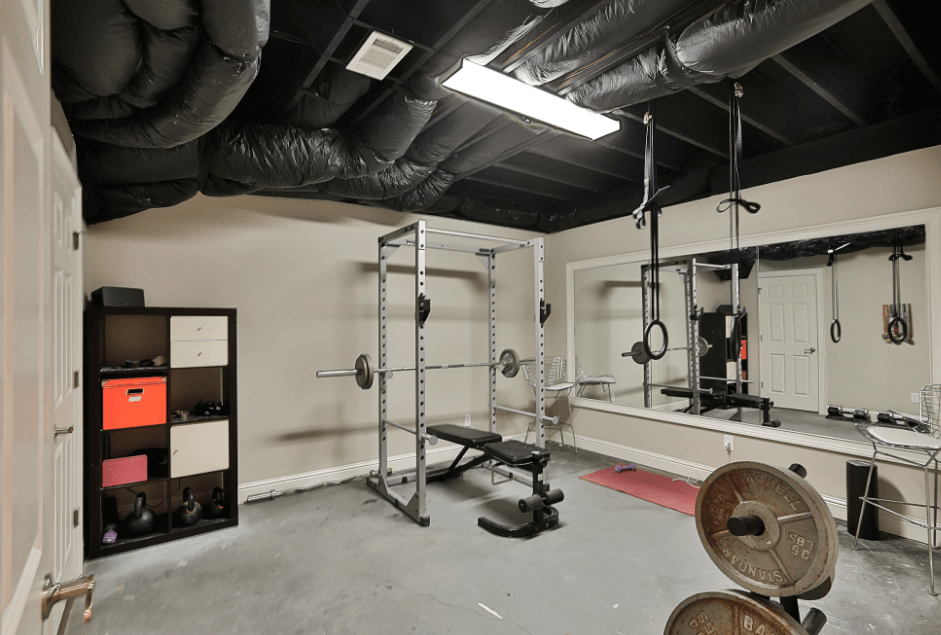
Overhead lights are the easiest way to fill your gym with light. They are the go-to choice for basement gyms and on many on occasion, you might need just one overhead light fixture to light up a smallish gym.
Since we are talking about low ceilings, recessed spotlights might be a better choice than track lighting. If you want to even the lighting out, you can use a combination of the two. Recessed spotlights overhead to fill the room and track lights to highlight your most important equipment.
Some new LED light fixtures can be mounted on the ceiling and the wall. Moreover, you generally have the flexibility to choose the intensity of the light fixtures. LEDs are available in anything from 50 to 5000 lumens or more.
Some good examples are the POLARPRA 150W LED Garage Light & the Tanbaby LED Garage Light.
Floor lamps

In one of our DIY basement gym projects, we discovered midway that there was only room for one overhead light fixture. Floor lamps helped us illuminate the dark depths of the gym that were beyond reach.
If you are going to use floor lamps, look for directional ones so that they can be rotated if need be.
Rechargeable lights

Rechargeable lights are portable, battery powered lights that can be moved around the gym as and when required. While the idea of portability seems great, we generally do not recommend these as a primary lighting source.
The last thing you need is the battery running out when you are in the midst of a set and looking to rack the bar.
What Should You Do with Your Basement Walls?
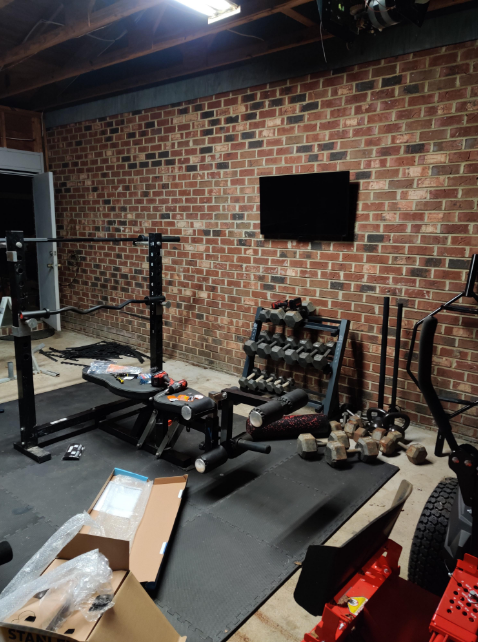
Does your basement resemble a jail cell? Then even a fresh coat of paint can do wonders for the appearance.
If you are space constrained, just install some mirrors. Mirrors will reflect light and create the illusion of a much larger space. An innate benefit is that there’s no dearth to the amount of selfies you can click.
Unless you plan to practice martial arts, we wouldn’t recommend wall pads.
What Kind of Equipment Can Be Added to A Low Ceiling Gym?

Remember what we mentioned a while ago about sticking to the essentials only?
For most people, here’s the essential basement gym equipment list.
Shortie Power Rack
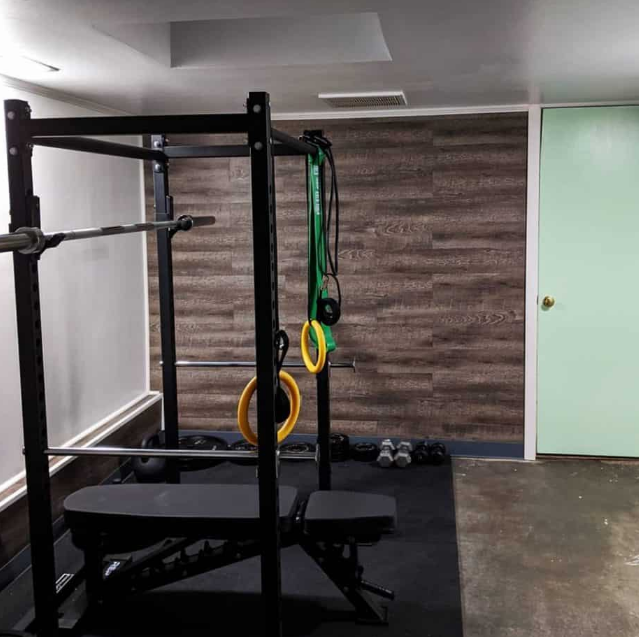
A power rack is the most basic equipment that’s a must have in every gym. If you lift weights, you need one of these. They will help you lift a fair bit of weight without the need for a spotter. A shorty rack is a low-height option designed for basement gyms and other rooms with low ceilings. You have some great options.
Rep PR 1050
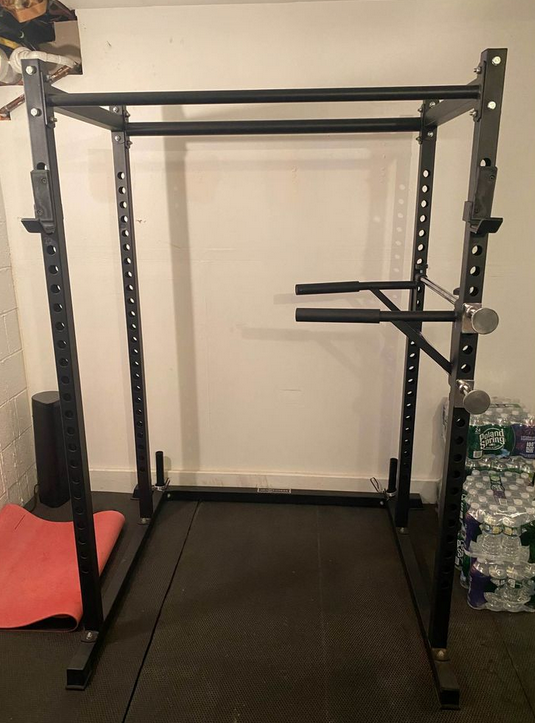
72” Tall with a flat foot design that need not be bolted to a platform.
Titan T2
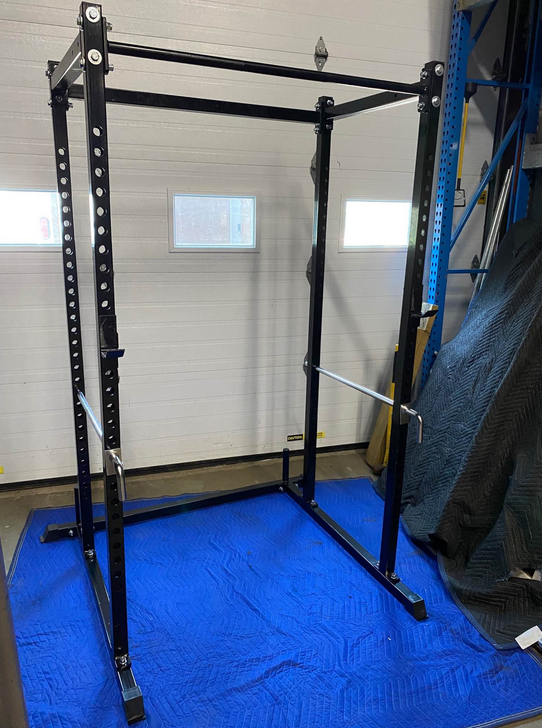
71” Tall with an integrated pull-up bar and a bunch of additional accessories to boot
Titan X3
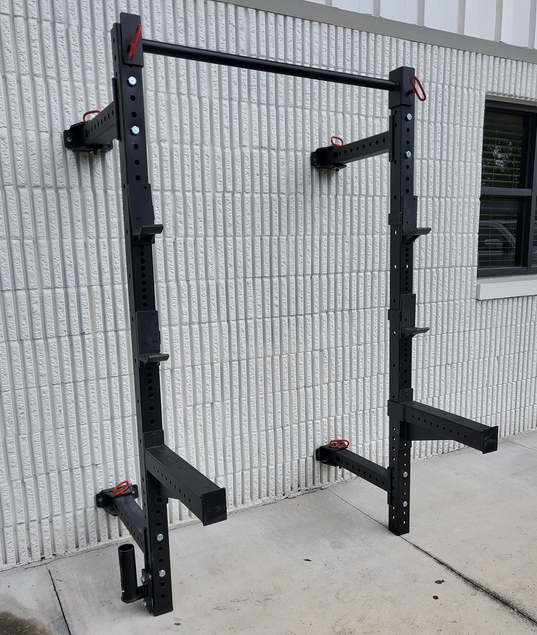
82” option in case that works for you!
Bench
You need a small weight bench that can sustain the amount of weight you lift. It doesn’t matter if it’s a fancy adjustable one or a basic one.
Rogue Flat Bench

As simple as it gets. Built like a tank and a one-piece design.
Titan Fitness Max FID
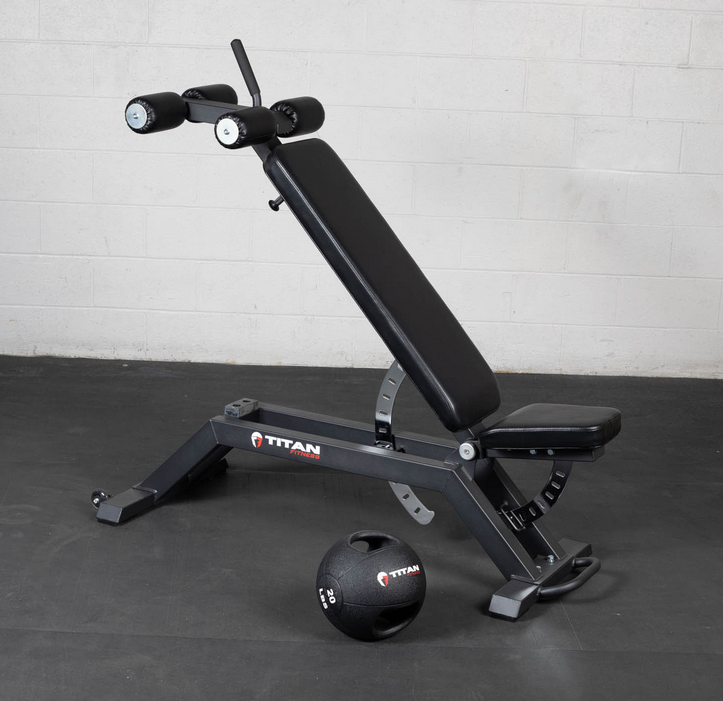
If you prefer an adjustable version, here’s the Max FID from Titan Fitness. You get 10-adjustable bench positions. Go figure.
Olympic Barbell
Basically any quality Olympic barbell should be work great for a standard basement gym. After all the bar's weight and dimensions won't have a big impact on how it fits in your basement gym.
The only deciding factor is the weight load that it can sustain. Always go for a little extra. If your max lift is 500 lb., go for a bar that can sustain at least 750 lbs.
Rogue Ohio 2.0
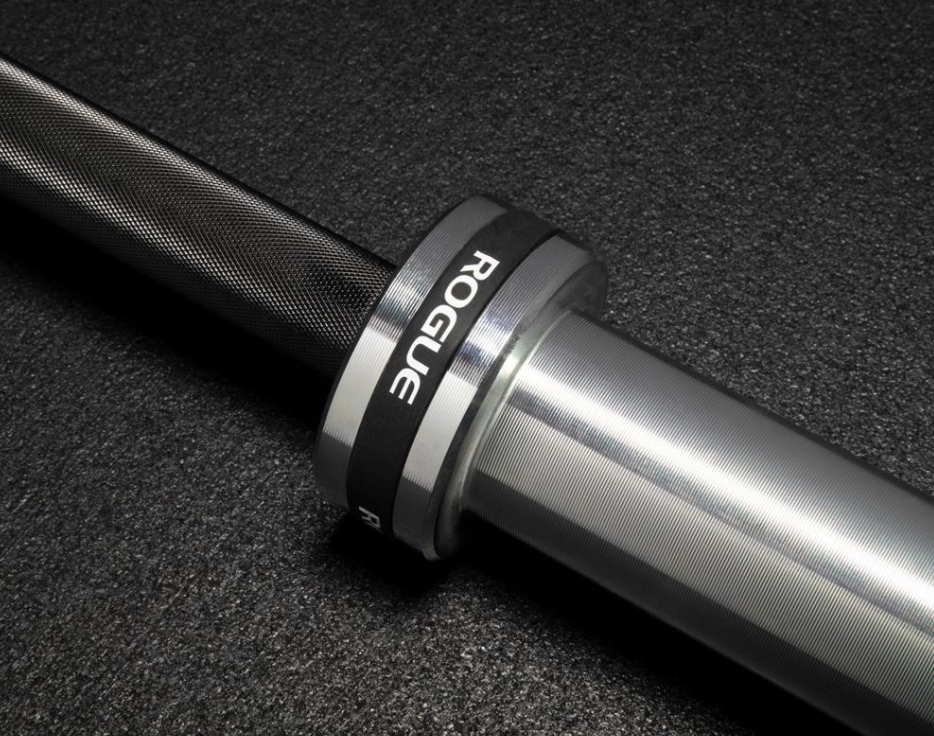
Probably the best option out there. Comes in 700, 1000 & 1500 lb. weight capacities.
Rep Basic Bar

700 lb. capacity. 2” sleeves. Budget Priced.
Everything else is an addition. Some decisions might be tougher than they seem. For instance, you may have to choose between an adjustable bench and a prowler sled.
The eventual choice is subjective. But most people would put their money on the bench. Be pragmatic. Only if you have spare cash, go for things that you’d rarely use, but would still be worth the money. For example, Kettlebells or Farmer’s walk handles.
Other Equipment to consider

Here are more exercise equipment to consider
Rep Farmer’s Carry Handles
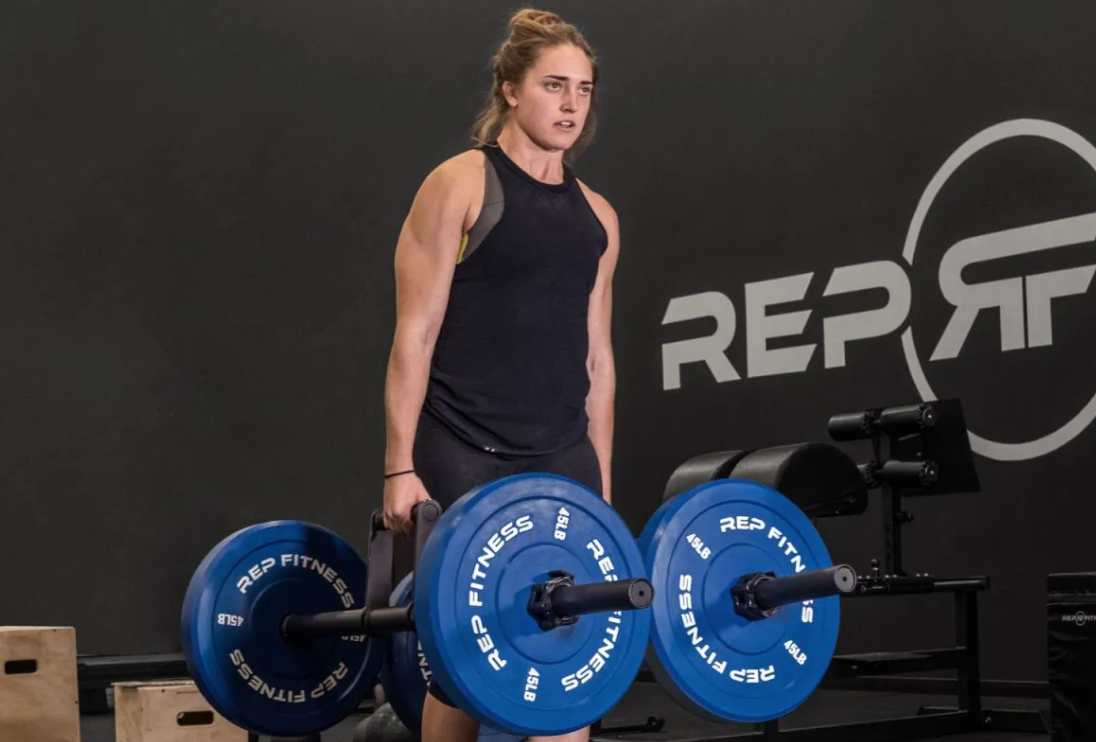
35 Lbs. Plates with a 14” Diameter (Can save at least 3.5” on OHP)
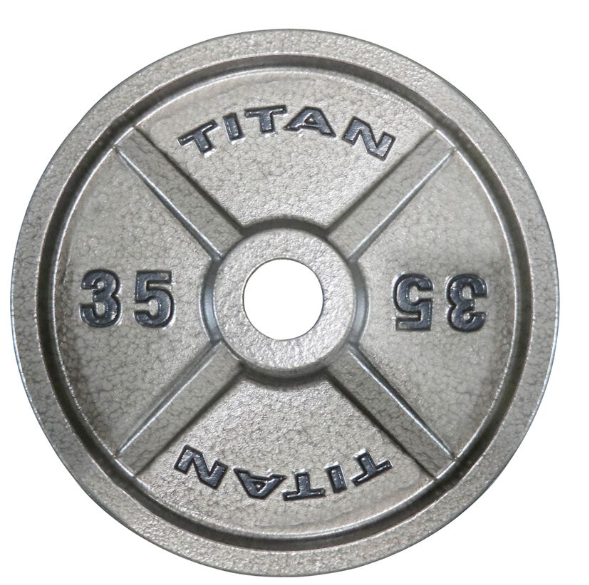
Marcy 3-Tier Dumbbell rack

Rogue Dumbbells
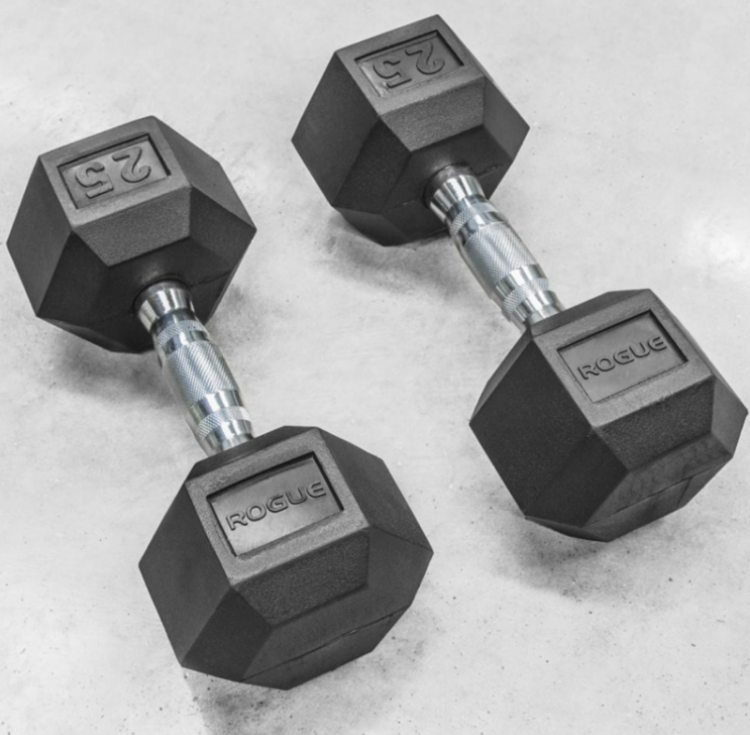
If you want more than just the essentials; maybe you want to add a treadmill that is suitable for low ceilings, an all-in-one home gym machine that fits a small place, an exercise bike or an elliptical or in general you want home gym equipment that suits a small place, we have articles on all these topics you should check them out.
How to Perform Exercise Comfortably in A Low Ceiling Basement Gym
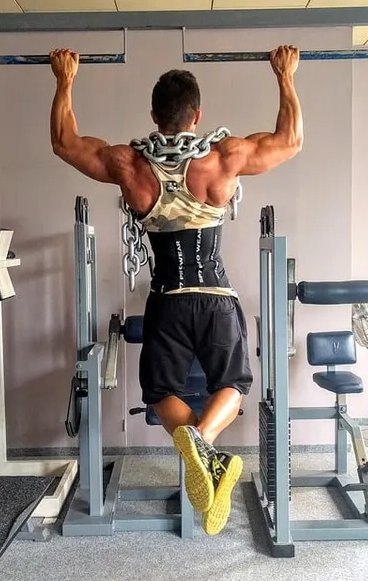
Sometimes we feel that low ceilings are unfairly maligned. They are not as much of a hindrance as they are often made out to be.
You are probably going to struggle with some overhead moves depending on how tall you are. And definitely something like upside down pull ups is off the table.
Anyone who’s taller than 6’ will be scraping the ceilings if they try to do the OHP standing. But there are easy workarounds as long as you watch your form. Here are two great alternatives for the OHP.
The Z Press
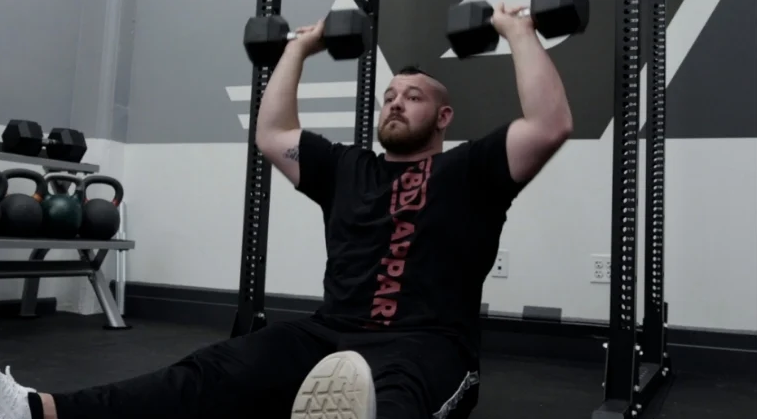
This overhead press variation designed by Zydrunas Savickas (Big Z), is better than the overhead press given that it involves more stabilizer muscles. Also, unlike the conventional seated press, the chances of you overextending your spine are close to zilch.
Here’s a video that shows how to perform the Z press.
I like combining the Z press with another exercise that is suitable for low ceilings; the Australian pull up, this allows me to work the biceps, triceps, and most of my upper body with only two exercises.
How to Lift with a Low Ceiling
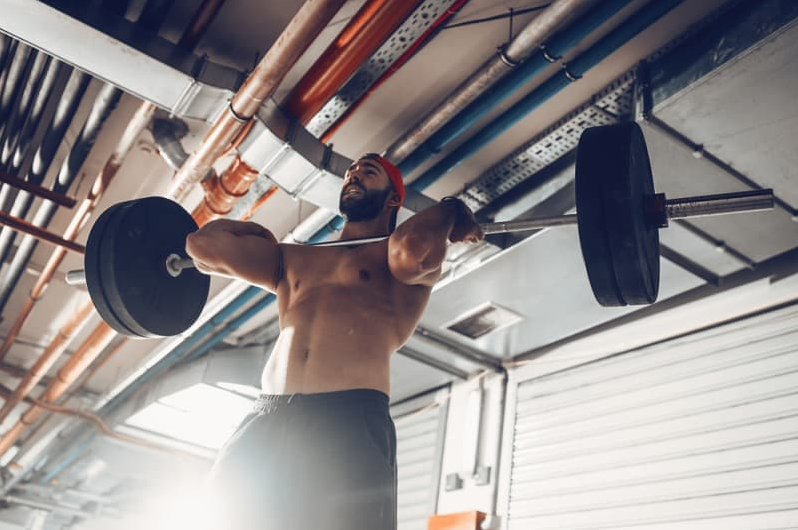
The other exercise that tall people struggle with is the pull up (depending on what defines being tall, of course. But generally 6 foot and above).
Most squat racks come with pull up bar attachments. Even the shorty racks that we have listed above, include a pull up bar. At 72” they are probably not the ideal choice. But if you can bend your knees, you can do a full chest-over-the-bar pull up without your head crashing into the ceiling.
You need roughly 12-18” of clearance above the bar to do a full pull up. You can also lower the bar by the way.
Since the pull up bar is usually a permanent attachment to the rack, you can use the barbell with J-Hooks and attach resistance bands to the hooks. The other way is to swap the pull up bar gymnastic rings.
How to Manage Storage in A Small Space of A Basement Low Ceiling Gym

When you are planning to set up a gym in a compact space like the basement, you should always try to maximize the functionality of the available space.
While you don’t want to go overboard with storage, you also want to ensure that the gym doesn’t look like an unorganized mess.
Some tips
- Multifunctional equipment when possible
- Plan everything in advance
- Use folding equipment
- Use space planning.
Here’s a great YouTube video that shows you how to do that.
FAQ
Here’s a brief FAQ that covers some of the questions that might arise in your mind while turning a bug-graveyard, basement into a gym with a low ceiling.
Can You Set up A Basement Gym on A Shoestring Budget?

Sure. You don’t need swanky flooring or fancy equipment for a functional gym. As long as the floor’s level, there’s no water seepage, no moisture and no pests, you are good to go. As far as equipment is concerned, you can always buy used, if new seems too pricey.
And as we discussed for the essential equipment you can always find affordable options; cheap racks, cheap barbells, cheap dumbbells, you name. But always do you research and you will be surprised how far your money can go.
Can You Get a Good Workout in A Basement Gym?
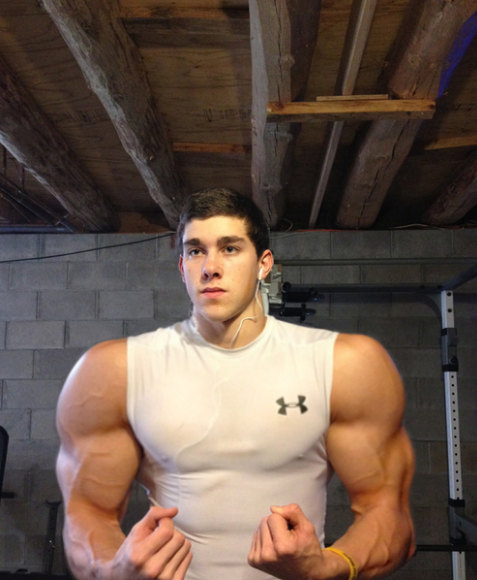
Absolutely. The effectiveness of your workout depends on the program, your intensity, your form, nutrition and rest, more than the type of equipment that you perform it on. So, as long as you have everything else dialed down, you can get a terrific workout in your basement gym.
Don't worry, if you have skinny arms, you can bulk them up like this dude in the image no problem by following the same steps you would follow in a regular gym
Closing Thoughts
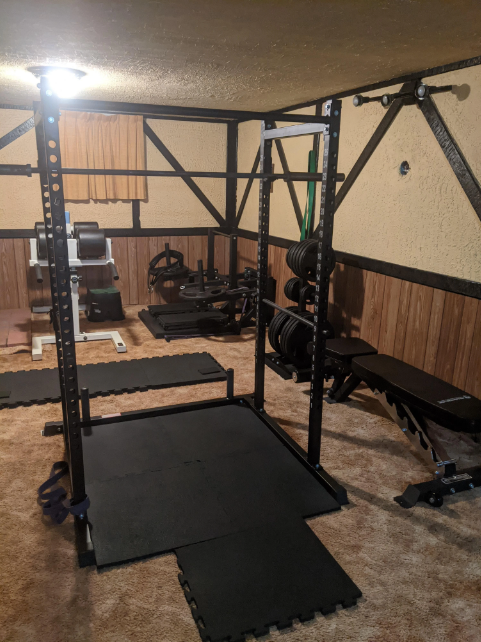
There’s a gym lying dormant in every basement in the world. You just need to wake it up and give it a shiny new superhero costume.
We hope that this article gives you the necessary information and some motivation to set up your first home gym. Do share your thoughts and ideas with us. We’d love to hear more about how your project went.
Related Readings:
- Best Home Gym for Beginners – Top Bang For Buck Options For Newbies
- 11 Best Home Gyms for Bodybuilding – With & Without Weights – Reviewed
- 7 Best Arm Exercise Bikes – Reviewed & Rated
- What Should I Workout After Chest Day? The All-You-Need-To-Know Guide
- Chest Press Vs Bench Press – What are the Differences? Which is Better?
- Nordictrack vs Peloton vs Bowflex
Resources:
- https://health.clevelandclinic.org/80-of-americans-dont-get-enough-exercise-and-heres-how-much-you-actually-need/
- https://codes.iccsafe.org/content/IRC2018
- https://www.fixr.com/costs/basement-remodeling
- https://en.wikipedia.org/wiki/Janka_hardness_test
- https://furthermore.equinox.com/articles/2015/03/lighting-fitness
- https://www.alconlighting.com/media/AlconLighting_DeterminingLumens.pdf
Ben Mayz
Hi there! I'm Ben, main author and chief editor at Fitlifefanatics.com. I have been obsessed with Strength Training and Fitness for 18 years now.
My passion for living a happy fit lifestyle is what made me realize that fitness is what I wanted for my future.
I went on to earn my Masters in Sports Training & Biomechanics.
My passion for Strength training & fitness and my love of helping others is what made me start Fitlifefanatics.
Here, myself, and a team of specialist aim to provide the most accurate, and actionable information possible in hopes to help foster the fitness community forward.
You can learn more about Fitlifefanatics on our About Page


